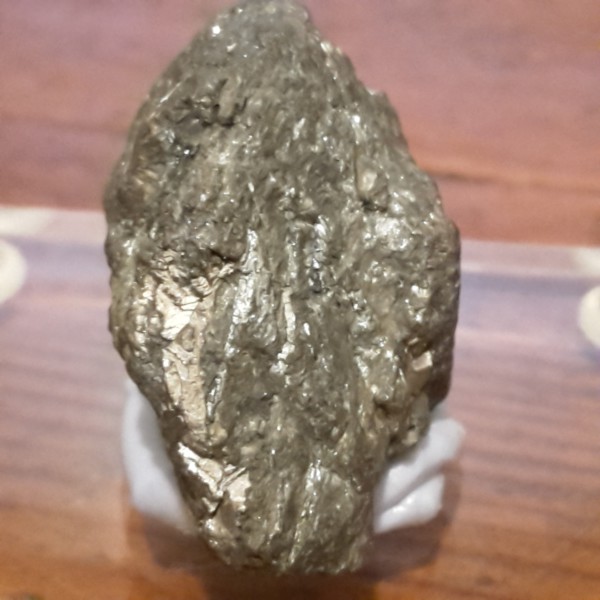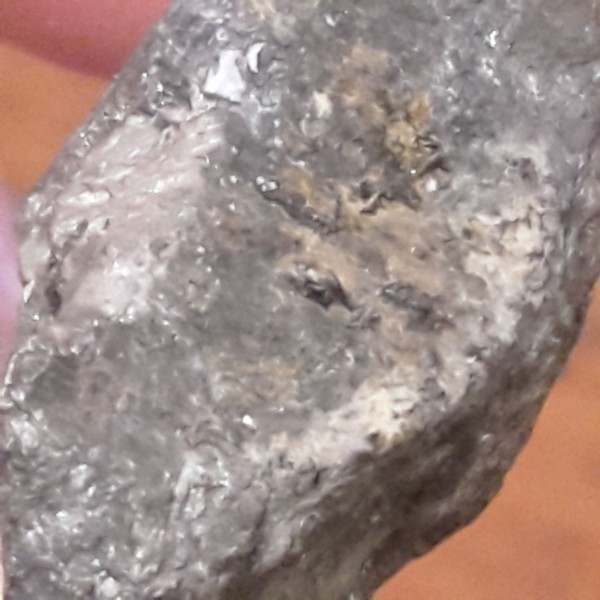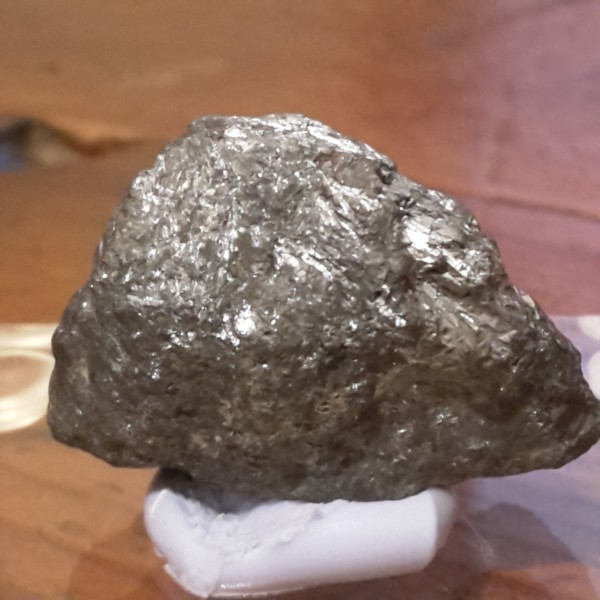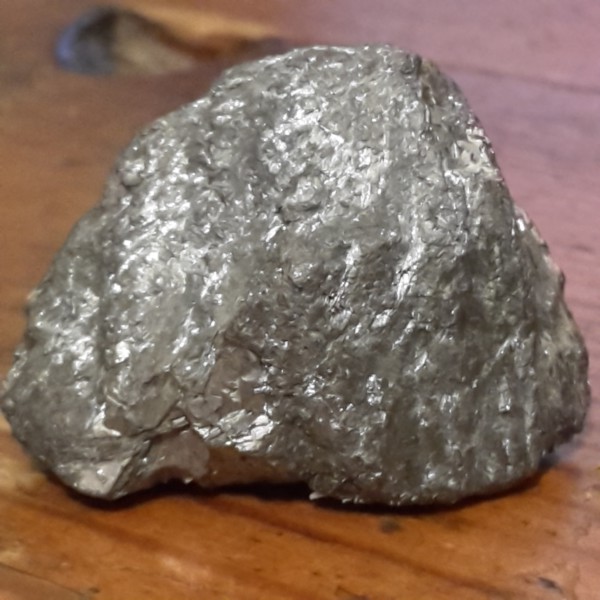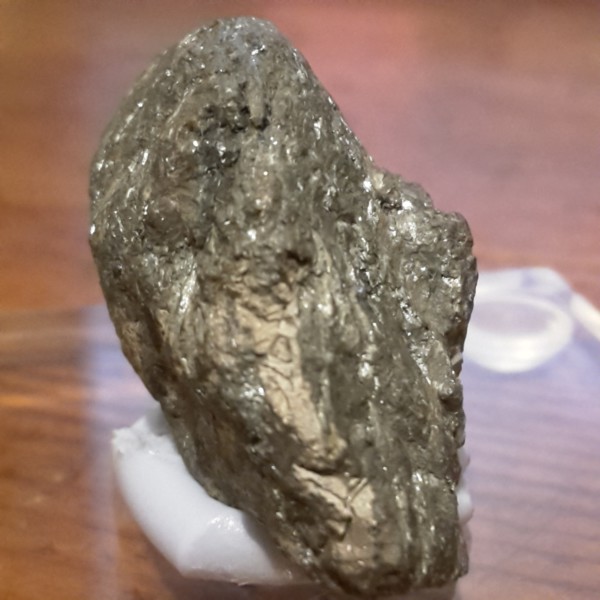No products in the cart.
Australian Minerals, Metal Specimens, Minerals of the World
BISMUTHINITE
BISMUTHINITE RARE
Availability:
Out of stock
Bismuthinite Rare Bismuth specimen. A little beauty with some white green sulfide sprinkled between the crevices. The close up pic shows typical crystal form. The specimen is on a perspex pad for enhanced display.
Dimensions:
2.9cm x 2.2cm x 1.6cm, 35g.
Location:
Wolfram Camp, Australia.
BISMUTHINITE
Bi2S3
Bismuth Sulfide
Bismuthinite is an important ore of bismuth. Sprays of steel gray prismatic bismuthinite crystals radiate outward from a common attachment point in the more spectacular specimens of this somewhat rare sulfide mineral. These specimens can not help but be compared to specimens of stibnite. It is difficult to distinguish from the similar looking and closely related antimony sulfide. Bismuthinite is heavier than stibnite and on closer inspection of the crystals, there exists a noticeable difference with bismuthinite’s having straighter, flatter faces. In massive form the confusion is even more pronounced, but bismuthinite is not associated with the typical antimony or arsenic minerals to which stibnite is so commonly allied.
Check out more Metal Specimens for sale here
Check out the Periodic Table of the Elements here
Compare
BISMUTHINITE RARE
Bismuthinite Rare Bismuth specimen. A little beauty with some white green sulfide sprinkled between the crevices. The close up pic shows typical crystal form. The specimen is on a perspex pad for enhanced display.
Dimensions:
2.9cm x 2.2cm x 1.6cm, 35g.
Location:
Wolfram Camp, Australia.
BISMUTHINITE
Bi2S3
Bismuth Sulfide
Bismuthinite is an important ore of bismuth. Sprays of steel gray prismatic bismuthinite crystals radiate outward from a common attachment point in the more spectacular specimens of this somewhat rare sulfide mineral. These specimens can not help but be compared to specimens of stibnite. It is difficult to distinguish from the similar looking and closely related antimony sulfide. Bismuthinite is heavier than stibnite and on closer inspection of the crystals, there exists a noticeable difference with bismuthinite’s having straighter, flatter faces. In massive form the confusion is even more pronounced, but bismuthinite is not associated with the typical antimony or arsenic minerals to which stibnite is so commonly allied.
Associations of bismuthinite are varied, but combinations with the rare elemental mineral bismuth are particularly special. Chalcopyrite is another especially common associate. The carbonate mineral bismutite, Bi2(CO3)O2, is found as an alteration (oxidation) product of bismuthinite and often is found as pseudomorphic crystals after bismuthinite. A pseudomorph is an atom by atom replacement of one mineral by another without significant changes in the outward appearance of the crystals (pseudo=”false” and morph=”shape”).
PROPERTIES
Colour is steel gray to off-white.
Luster is metallic.
Transparency crystals are opaque.
Crystal System is orthorhombic; 2/m 2/m 2/m
Crystal Habits include radiating acicular to prismatic columnar crystals. Sometimes in wonderful sprays that are similar to stibnite’s crystal habits. Also granular and massive.
Cleavage is perfect in one lengthwise direction.
Fracture is uneven.
Hardness is 2
Specific Gravity is approximately 6.8 – 7.2 (well above average for metallic minerals)
Streak is gray.
Other Characteristics: Thin crystals are slightly flexible, but inelastic. There maybe a slight yellow or iridescent tarnish present. Crystals are usually striated and have some sectility.
Associated Minerals are numerous and include gold, bismuth, bismutite, quartz, andradite, chrysoberyl, almandine, barite, scheelite, pyrophyllite, kettnerite, wulfenite, gadolinite, wolframite, beryl, epidote, microcline, pyrite, chalcopyrite, arsenopyrite, covellite and several other sulfides.
Notable Occurrences are many and include Cornwall, England; Bolivia; Australia; Temiscaming County, Quebec, Canada; Guanajuato, Mexico; Brazil; Kingsgate, New South Wales, Australia and some excellent locations in Vogtland and Siegerland, Germany. From the United States there are several localities in Haddam, Connecticut; Beaver County, Utah; Kern County, California; several counties in Arizona and in Boulder County, colourado.
Best Field Indicators are crystal habit, density, tarnish, softness and flexibility.
BISMUTH Bi
ELEMENT 83.
Of interest to hobbyists are the pseudocubic hopper crystals that are always present on the laboratory produced specimens, they are not seen in but only the rarest of natural crystals. Hopper crystals are also found in Galena (sometimes called skeletal crystals) and Halite. Hopper crystals are a unique crystallographic curiosity Just the edges extend outward from the center of the crystal leaving hollow stair step faces between these edges. The hopper crystals form due to the disparity of growth rates between the crystal edges and the crystal faces. A few interesting properties is that Bismuth shrinks when heated. It is the second most diamagnetic material occurring naturally.
The diamagnetic forces are extremely weak. Diamagnetic materials, like water, or water-based materials, have a relative magnetic permeability that is less than or equal to 1, a magnetic susceptibility less than or equal to 0. Bismuth = 0.999834.
Interesting Elementals
It is the second most diamagnetic material naturally occurring, the first is Graphite. This is great to make magnetic levitating displays using neo magnets.
It shrinks as it heats up, only a few substances do this like water up to 4°C. It has a low melting point 271.4°C so you can melt it in a pot on the stove. Bismuth oxide is used in medicine such as quick ease to reduce stomach acid build up. Bismuth is Element 83 on the Periodic Table.
Check out more Metal Specimens for sale here
Check out the Periodic Table of the Elements here
SKU: AM23BR01 Categories: Australian Minerals, Metal Specimens, Minerals of the World Tags: Bi2S3, BISMUTH, Bismuth Sulfide, Bismuthinite, NATIVE BISMUTH, NATIVE BISMUTH RARE, rare
| Weight | 35 g |
|---|---|
| Dimensions | 12 × 10 × 8 cm |
| color | Metallic Silver Grey |
BISMUTHINITE RARE
Bismuthinite Rare Bismuth specimen. A little beauty with some white green sulfide sprinkled between the crevices. The close up pic shows typical crystal form. The specimen is on a perspex pad for enhanced display.
Dimensions:
2.9cm x 2.2cm x 1.6cm, 35g.
Location:
Wolfram Camp, Australia.
BISMUTHINITE
Bi2S3
Bismuth Sulfide
Bismuthinite is an important ore of bismuth. Sprays of steel gray prismatic bismuthinite crystals radiate outward from a common attachment point in the more spectacular specimens of this somewhat rare sulfide mineral. These specimens can not help but be compared to specimens of stibnite. It is difficult to distinguish from the similar looking and closely related antimony sulfide. Bismuthinite is heavier than stibnite and on closer inspection of the crystals, there exists a noticeable difference with bismuthinite’s having straighter, flatter faces. In massive form the confusion is even more pronounced, but bismuthinite is not associated with the typical antimony or arsenic minerals to which stibnite is so commonly allied.
Associations of bismuthinite are varied, but combinations with the rare elemental mineral bismuth are particularly special. Chalcopyrite is another especially common associate. The carbonate mineral bismutite, Bi2(CO3)O2, is found as an alteration (oxidation) product of bismuthinite and often is found as pseudomorphic crystals after bismuthinite. A pseudomorph is an atom by atom replacement of one mineral by another without significant changes in the outward appearance of the crystals (pseudo=”false” and morph=”shape”).
PROPERTIES
Colour is steel gray to off-white.
Luster is metallic.
Transparency crystals are opaque.
Crystal System is orthorhombic; 2/m 2/m 2/m
Crystal Habits include radiating acicular to prismatic columnar crystals. Sometimes in wonderful sprays that are similar to stibnite’s crystal habits. Also granular and massive.
Cleavage is perfect in one lengthwise direction.
Fracture is uneven.
Hardness is 2
Specific Gravity is approximately 6.8 – 7.2 (well above average for metallic minerals)
Streak is gray.
Other Characteristics: Thin crystals are slightly flexible, but inelastic. There maybe a slight yellow or iridescent tarnish present. Crystals are usually striated and have some sectility.
Associated Minerals are numerous and include gold, bismuth, bismutite, quartz, andradite, chrysoberyl, almandine, barite, scheelite, pyrophyllite, kettnerite, wulfenite, gadolinite, wolframite, beryl, epidote, microcline, pyrite, chalcopyrite, arsenopyrite, covellite and several other sulfides.
Notable Occurrences are many and include Cornwall, England; Bolivia; Australia; Temiscaming County, Quebec, Canada; Guanajuato, Mexico; Brazil; Kingsgate, New South Wales, Australia and some excellent locations in Vogtland and Siegerland, Germany. From the United States there are several localities in Haddam, Connecticut; Beaver County, Utah; Kern County, California; several counties in Arizona and in Boulder County, colourado.
Best Field Indicators are crystal habit, density, tarnish, softness and flexibility.
BISMUTH Bi
ELEMENT 83.
Of interest to hobbyists are the pseudocubic hopper crystals that are always present on the laboratory produced specimens, they are not seen in but only the rarest of natural crystals. Hopper crystals are also found in Galena (sometimes called skeletal crystals) and Halite. Hopper crystals are a unique crystallographic curiosity Just the edges extend outward from the center of the crystal leaving hollow stair step faces between these edges. The hopper crystals form due to the disparity of growth rates between the crystal edges and the crystal faces. A few interesting properties is that Bismuth shrinks when heated. It is the second most diamagnetic material occurring naturally.
The diamagnetic forces are extremely weak. Diamagnetic materials, like water, or water-based materials, have a relative magnetic permeability that is less than or equal to 1, a magnetic susceptibility less than or equal to 0. Bismuth = 0.999834.
Interesting Elementals
It is the second most diamagnetic material naturally occurring, the first is Graphite. This is great to make magnetic levitating displays using neo magnets.
It shrinks as it heats up, only a few substances do this like water up to 4°C. It has a low melting point 271.4°C so you can melt it in a pot on the stove. Bismuth oxide is used in medicine such as quick ease to reduce stomach acid build up. Bismuth is Element 83 on the Periodic Table.
Check out more Metal Specimens for sale here
Check out the Periodic Table of the Elements here
You may also like…
- Crystals, Metal Specimens
ELEMENT 83 BISMUTH Bi 16
ELEMENT 83 BISMUTH Bi
Element 83 Bismuth Bi Crystal Cluster. This is top quality material. Displaying the full rainbow of colours in the sought after hopper crystal shapes. Bismuth Crystals appeal to everyone from kids, geology students, mineral collectors and crystal lovers. Who can blame us with the amazing stair pyramid shapes and rainbow of colours it displays. This mineral whether in its natural native form or in this type has some truly amazing properties that puts it in a class of its own. My photos don’t do this Bismuth justice.
Dimensions:
5.2cm x 4.2cm x 2.8cm, 63g.BISMUTH Bi
SKU: C1116 - Australian Minerals, Crystals, Metal Specimens, Minerals of the World
MAGNETITE CRYSTAL
MAGNETITE CRYSTAL
A single Magnetite Crystal, showing very good crystal shape. An interesting piece for metal or Aussie collectors, hard to come across for sale. The specimen is mounted on a perspex pad for enhanced display. We have added a small neo magnet which sticks well.
Location:
Yinnietharra, Western Australia.Dimensions:
1.9cm x 1.9cm x 1.7cm, 13g.Magnetite:
Fe2+Fe23+O4.SKU: MW7433 - Australian Minerals, Crystals, Metal Specimens, Minerals of the World
CRYSTAL MOLYBDENITE
A large lustrous specimen of an Aussie Crystal Molybdenite. There is no matrix to speak of, it’s all crystal. Hard to find in this size. Molybdenite is the main ore of the metal molybdenum. A great addition to your metals collection. Some are using specimens like this Molybdenite Crystal as a power transistor by slight modification in the lab. The Yellow oxide on the back of this specimen is a good indicator of Bismuthinite. This specimen was difficult to photograph due to the metals high reflection.
Location:
Wolfram Camp, QLD, Australia.Dimensions:
6.2cm x 3.7cm x 1.3cm, 34g.MoS2
Molybdenum Sulfide.SKU: n/a - Crystals, Metal Specimens
ELEMENT 83 BISMUTH Bi 23
ELEMENT 83 BISMUTH Bi
Element 83 Bismuth Bi Crystal Cluster. This is top quality material. Displaying the full rainbow of colours in the sought after hopper crystal shapes. Bismuth Crystals appeal to everyone from kids, geology students, mineral collectors and crystal lovers. Who can blame us with the amazing stair pyramid shapes and rainbow of colours it displays. This mineral whether in its natural native form or in this type has some truly amazing properties that puts it in a class of its own. My photos don’t do this Bismuth justice.
Dimensions:
5.2cm x 3.5cm x 3.5cm, 46g.BISMUTH Bi
SKU: C1123 - Crystals, Metal Specimens
ELEMENT 83 BISMUTH Bi 15
ELEMENT 83 BISMUTH Bi
Element 83 Bismuth Bi Crystal Cluster. This is top quality material. Displaying the full rainbow of colours in the sought after hopper crystal shapes. Bismuth Crystals appeal to everyone from kids, geology students, mineral collectors and crystal lovers. Who can blame us with the amazing stair pyramid shapes and rainbow of colours it displays. This mineral whether in its natural native form or in this type has some truly amazing properties that puts it in a class of its own. My photos don’t do this Bismuth justice.
Dimensions:
6.9cm x 3.9cm x 2.4cm, 66g.BISMUTH Bi
SKU: C1115
Related products
- Australian Minerals, Metal Specimens, Minerals of the World
WOLFRAMITE QUARTZ
WOLFRAMITE QUARTZ
Wolframite Quartz Specimen to add to your horde. Good Aussie metal specimen of an uncommon mineral. This specimen is mounted on a perspex pad for enhanced display.
Location:
Wolfram Camp, Queensland, Australia.Dimensions:
5.5cm x 4.2cm x 2.4cm, 102g.Iron Manganese Tungstate (Fe, Mn)WO4
SKU: MW5665 - Australian Minerals
PSEUDOMORPH MALACHITE CUPRITE
PSEUDOMORPH MALACHITE CUPRITE
A rare Australian mineral specimen of Pseudomorph Malachite Cuprite. You can clearly see that the Malachite is not in one of its natural forms, but instead is more like cuprite or copper. A pseudomorph is when one mineral is chemically replaced by another mineral without changing the external form of the original mineral. In this case the Malachite has replaced the original Cuprite mineral. There is also Smithsonite on this specimen. A very collectible piece, both for that fact is a pseudomorph and also because it is a rare mineral from a great location. An excellent gift or treat for the mineral collector and a must for the Australian Collection. This oresome mineral specimen is mounted on perspex to go straight into your cabinet.
Dimensions:
7cm x 4cm x 2.5cm, 90g
Location:
Block 14 Open Cut, South Mine, Broken Hill, NSW, AustraliaMalachite: Cu2(CO3)(OH)2
Smithsonite: ZnCO3
SKU: C0320 - Australian Minerals, Crystals
STELLERITE QUARTZ
STELLERITE QUARTZ
A beaut specimen of Stellerite Quartz featuring lovely peachy clusters of Stellerite on a Quartz base. Add a colourful boost to your cabinet with this great little piece. This specimen is well terminated and makes an attractive addition to your Australian mineral collection. A member of the Zeolite group of minerals. A great gift or treat for the collector.
Location:
Garrawilla Station, NSW, Australia.Dimensions:
4cm x 5.8cm x 3.8cm, 69g.Stellerite: Ca4(Si28Al8)O72 · 28H2O
SKU: AUSSTELL01 - Australian Minerals, Fluorescent Specimens, Minerals of the World, Opals
FLUORESCENT HYALITE OPAL 35
-5% Australian Minerals, Fluorescent Specimens, Minerals of the World, Opals
Australian Minerals, Fluorescent Specimens, Minerals of the World, OpalsFLUORESCENT HYALITE OPAL 35
A Fluorescent Hyalite Opal. This is a superb Aussie specimen to grace your collection. Rare to come by at this quality. Fluorescent Green under UVC light.
Location:
Squaretop Mountain, Queensland, Australia.Dimensions:
3.8cm x 3.5cm x 1.9cm, 19g.Hyalite
SiO2 · nH2O.A colourless variety of Opal. Hyalite is opal, an amorphous silica glass containing about 3-8% water. Hyalite occurs as globular and botryoidal masses and irregular crusts. Found in volcanic and pegmatite environments where the silica deposits from the gas phase. It often shows a strong green fluorescence in UV light.
Check out more Fluorescent Specimens here.
SKU: B2735$133$140 - Australian Minerals, Crystals, Galena, Metal Specimens, Minerals of the World, Pyrite
GALENA RHODONITE CRYSTALS
-20% Australian Minerals, Crystals, Galena, Metal Specimens, Minerals of the World, Pyrite
Australian Minerals, Crystals, Galena, Metal Specimens, Minerals of the World, PyriteGALENA RHODONITE CRYSTALS
Galena Rhodonite Crystals. A classic Aussie mineral & location, great as a specimen for display. Lovely colours and other interesting associated minerals, what looks like Pyrite. Galena showing great cubic crystal form with bright red Rhodonite. This specimen is mounted on a perspex pad for enhanced display.
Location:
Broken Hill, New South Wales, Australia.Dimensions:
10.5cm x 7.8cm x 9.1cm, 1108g.Rhodonite: MnSiO3.
Galena: PbS, Lead Sulfide.
SKU: n/a$120$150
